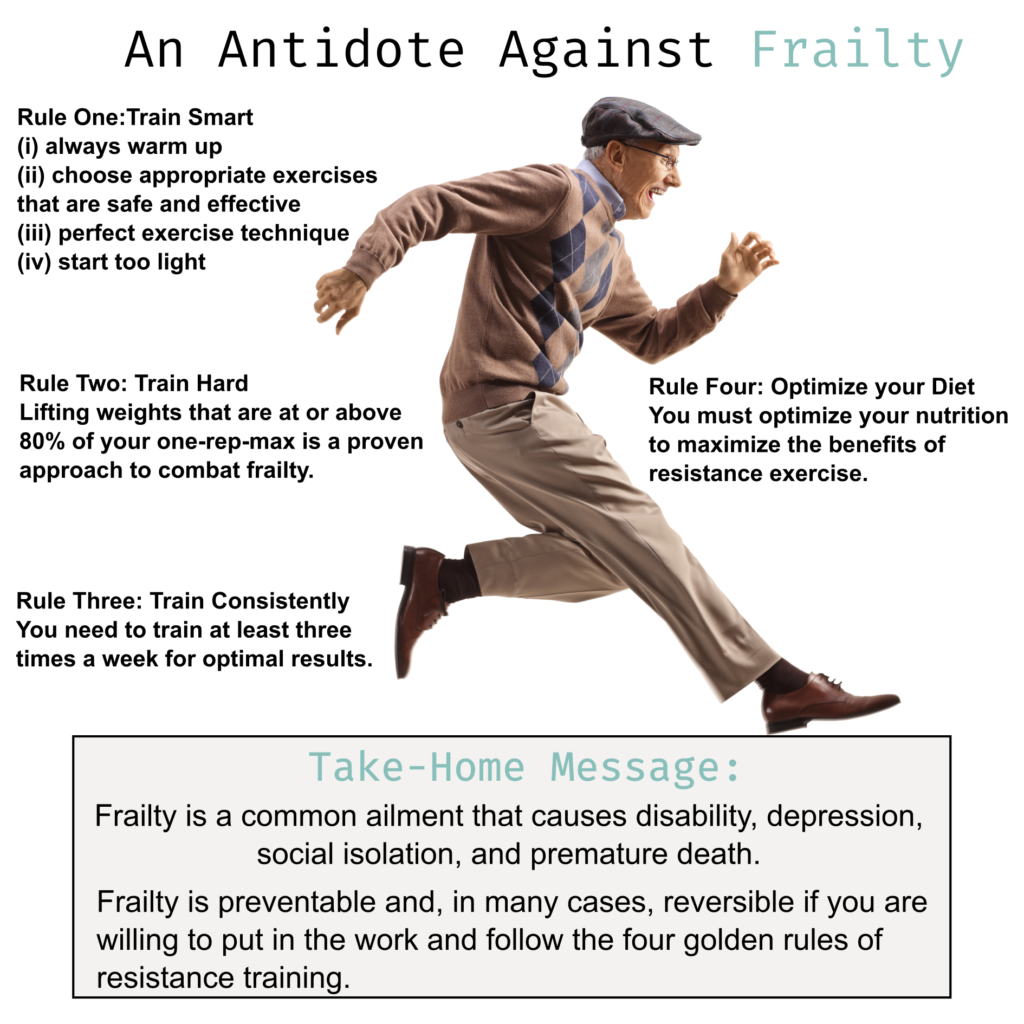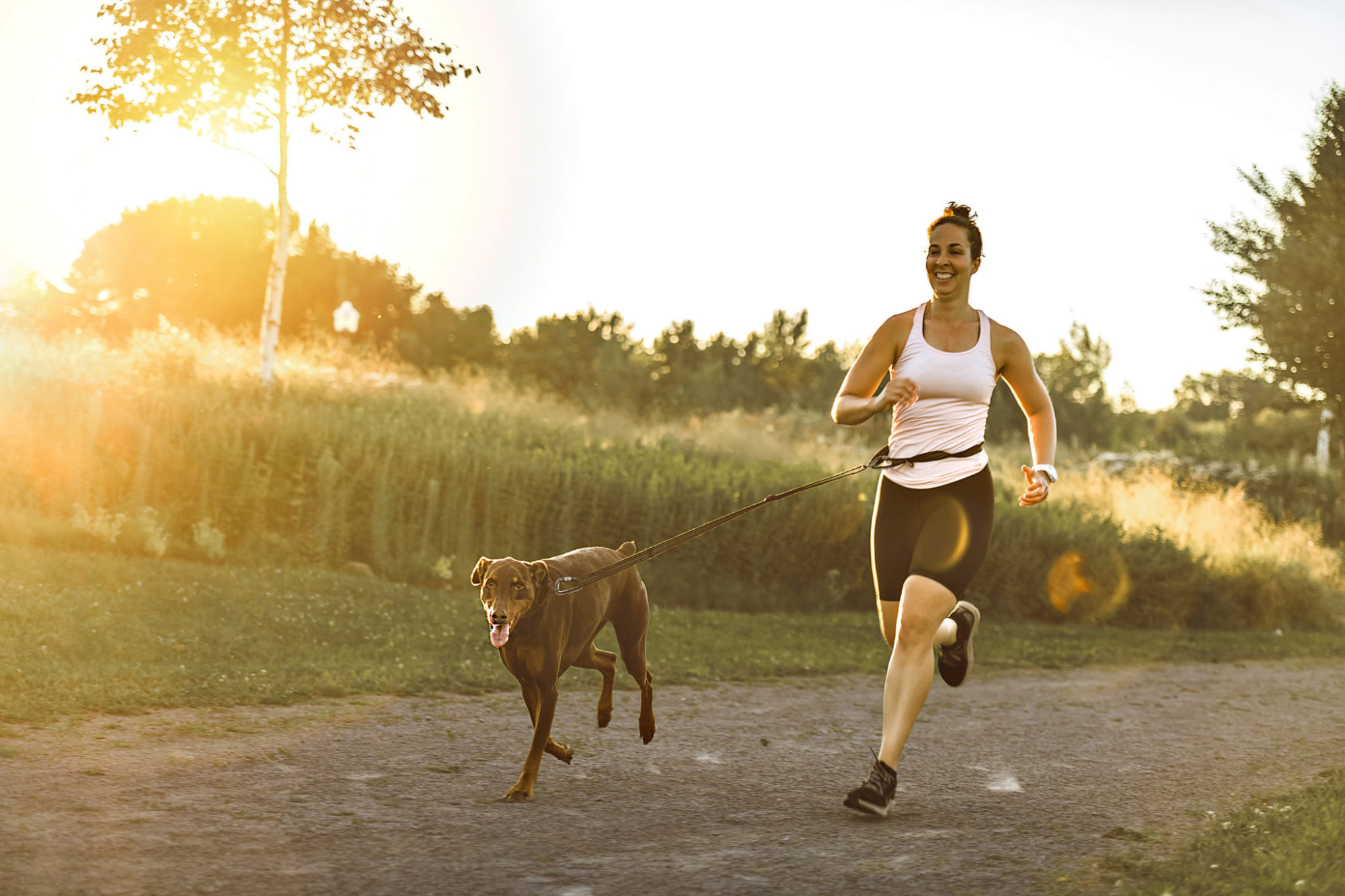An Antidote Against Frailty

Do not go gentle into that good night,
Old age should burn and rave at close of day;
Rage, rage against the dying of the light.
Dylan Thomas
Last Friday afternoon, I scheduled a hill-sprinting session at my local park. To my absolute horror, there were kids everywhere.
Families from the local school had decided to hold a BBQ next to my favorite sprinting hill.
Great!
I had two options. Option one, go home and do some other exercise. Option two, get my sprints done.
As I’d already warmed up, driven to the park, and put on my sprinting shoes, I figured to hell with them; I’m going to sprint as planned.
Maybe nobody would notice. And if they did, undoubtedly, they wouldn’t care.
Wrong.
Officially Old
As I walked down the hill after sprint number three, two young girls approached.
Uh oh.
“Mister, can we race you up the hill?”
“Sure.”
So, we raced.
And, to my great relief, I’m still faster than a 10-year-old kid. Whew!
Well, that’s that, I thought.
Wrong again. A swarm of boys approached. Finally, one detached himself from the group and asked:
“Mister, can I race you up the hill?”
“Sure.”
From then on, a new kid challenged me to race on each sprint.
By sprint seven, the parents had formed a crowd, cheering wildly as their kids raced and groaning dramatically at their inevitable defeat by the old-timer. Ha!
Unfortunately, I’m currently not hill-fit.
Thus, by sprint ten, I began to feel somewhat nauseous. Finally, faced with public humiliation, I called it quits before I lost my lunch in front of everyone.
Old, not Frail
As I was leaving, one of the mothers approached and said, “The kids can’t believe that an old man can run so fast!”
Ouch!
What is age-related frailty?
While the fact that I’m now officially considered “old” was a shocking revelation, the key takeaway is that most people think that old people are slow.
And people are justified in thinking so, given that many older adults are frail or on their way to becoming frail.
But what exactly do I mean by frail?
Frailty is an age-related syndrome that diminishes your strength, endurance, cognition, and immune function, making you more vulnerable to stress and illness (1).
Some other defining symptoms of frailty include:
- Weakness (e.g., low grip strength)
- Reduced speed (e.g., slow walking speed)
- Low endurance and rapid exhaustion
- Low physical activity
- Unintended weight loss, in particular, the loss of muscle mass
- Mild cognitive impairment
- Low bone density, with an increased risk of fracture
- Poor immune function
Because the aging process causes frailty, frailty increases with age (2).
Thus, you will become frail if you don’t take steps to prevent frailty as you get older.
So, how many older adults are frail?
The short answer is a lot!
Roughly 12-13% of people in the community are frail, with an astonishing 30% identified as being pre-frail (1, 3)!
Now before you dismiss these numbers as over-estimates, consider the following.
First, in addition to age, frailty is also increased by chronic diseases such as cancer, diabetes, HIV, and many other chronic health conditions (4).
Second, lifestyle and socioeconomic factors such as smoking, excessive drinking, obesity, chronic sleep disruption, poverty, low education, and social isolation all increase frailty (4).
Therefore, it’s easy to understand why frailty is so widespread when you appreciate how many factors contribute to frailty in addition to age.
Is frailty a severe health condition?
Yes, frailty is a severe health condition for the following reasons (5):
- Frailty doubles your chance of dying within the next seven years.
- Men can expect to suffer, on average, 17 years of disability, and women experience a whopping 20 years of disability at the end of their life (yikes!), primarily driven by frailty.
- Frailty is strongly associated with an increased risk of adverse events, including falls, succumbing to severe illness, hospitalization, and suffering permanent disability.
- Frailty increases your risk of depression and social isolation.
The hidden cost of frailty was manifest during the Covid-19 pandemic, where older frail patients experienced higher hospitalization rates and were far more likely to die from Covid-19 compared to non-frail patients (6).
Indeed, frail individuals are at a significantly elevated risk of infection, disease, and death from viral and bacterial infection compared to non-frail people (4).
So yeah, frailty sucks.
Rex, my first training mentor.
Rex, an ex-navy hard-ass, ran my local gym when I was a teenager.
At Rex’s gym, if newbies like me showed up at 6 am, we got to train with Rex.
Rex was an old-school lifter who loved to combine basic lifts with heavy weights and insane volume.
For example, a typical upper body day with Rex was ten sets of bench press, all done with perfect form, where Rex worked up to a maximum of 120 kg (for reps). After bench press, we performed chin-ups, arms (bis and tris), and finally, abs.
On leg days, Rex usually performed 20 sets of barbell squats, where he worked up to a heavy set of 200 kg (again, for reps) and then squatted back down the weights to “get some volume.”
Hamstring curls, calves, and abs followed this squatting hellscape.
One consequence of this brutality was that the delayed-onset muscle soreness after squatting with Rex was so bad that going to the toilet became a serious cost-benefit analysis.
However, the genuinely epic part of the story is that Rex performed these workouts at 68 years of age!
Rex’s Origin Story
Walking up a flight of stairs can be challenging for many older adults. So, witnessing Rex blasting out 200 kg squats like a belligerent war god at 68 years of age was mind-blowing!
However, this isn’t why Rex’s story is so inspiring.
You see, Rex wasn’t born a beast. He wasn’t a professional athlete. And he certainly wasn’t a life-long fitness junkie.
Instead, after leaving the Navy, Rex plunged into depression. And, like many depressed middle-aged men of his generation, he drank too much beer, smoked too many cigarettes, got fat and out of shape, and was earmarked for an early grave.
Then, at age 50, Rex looked in the mirror, declared, “f*ck this!”, joined a gym, and methodically transformed himself into a god of iron, business owner, and mentor of young men.
Can you prevent and reverse frailty?
Rex’s story proved to me that frailty need not be an inevitable consequence of aging. Hence, I’ve never considered old age a significant barrier to physical prowess.
But does science support my anecdotal experience?
The short answer is a cautious yes.
Pioneering studies on very old, frail patients that utilized high-intensity resistance training combined with nutritional interventions showed significant improvements in muscle strength, muscle size, and physical performance (7, 8).
However, subsequent studies have been more equivocal. For example, some exercise intervention studies show mild-to-moderate improvements in frail patients. In contrast, others don’t show any effect (reviewed in (5))!
What the hell is going on?
The Four Golden Rules of Training to Reverse Frailty
The emerging consensus is whether exercise interventions work to reverse frailty depending on training intensity and the participants’ commitment (5).
In the clinical trials where exercise and nutrition interventions did not work, participants were unsupervised, and drop-out rates were high (5).
In contrast, during effective interventions, the participants were supervised while exercising, exercise programs followed a progressive, high-intensity resistance training approach, and drop-out rates were low (5).
To reverse frailty, follow the four golden rules.
Rule One: Train Smart
Training smart means (i) always warming up, (ii) choosing appropriate exercises that are both safe and effective, (iii) perfecting exercise technique, and (iv) starting too light.
Starting too light means beginning with a manageable weight, allowing you to dial in your technique and get used to regular training before you load up the bar.
Lifting heavy weights with poor technique guarantees injury, so don’t do it.
Rule Two: Train Hard
Training hard means lifting weights that are sufficiently heavy to drive neuro-muscular adaptation. For example, lifting weights that are at or above 80% of your one-rep-max is a proven approach to combat frailty (7, 8).
And remember, execute each repetition with good technique to avoid getting hurt.
Rule Three: Train Consistently
You need to train at least three times a week, every week, for optimal results (7, 8).
Rule Four: Optimize your Diet.
If you’re an older adult, you must optimize your nutrition to maximize the benefits of resistance exercise (9).
And the crucial nutrient required for muscle growth is protein. Unfortunately, older adults need significantly more dietary protein after exercise to maximize muscle protein synthesis than younger adults (10, 11).
For example, older adults require 35 g of protein is needed to maximize rates of muscle growth for the average US male over 60 years (88 kg) (10), which is well above the 20 g serving recommended for young athletes (9).
Thus, consuming sufficient high-quality protein is essential to avoid frailty!
There are additional supplements that may help you avoid frailty (9). For example, oral creatine supplementation has long been known to improve the ability of older adults to perform high-intensity exercise, which over time, translates into greater muscular adaptation (9).
Furthermore, long-term supplementation with omega-3 fatty acids increases muscle protein synthesis, muscle volume, and muscle strength in older adults (9).
Take Home Message
Unfortunately, frailty is a common ailment that causes disability, depression, social isolation, and premature death.
However, frailty is preventable and, in many cases, reversible if you are willing to put in the work and follow the four golden rules of resistance training:
One, train smart- two, train heavy- three, train consistently- four, optimize your diet to support your training.
Indeed, the moral of Rex’s story is that despite being old, depressed, and horribly out of shape, Rex transformed himself into one of the strongest people in the gym by following the four golden rules.

References and Further Reading
1. R. O’Caoimh et al., Prevalence of frailty at population level in European ADVANTAGE Joint Action Member States: a systematic review and meta-analysis. Ann Ist Super Sanita 54, 226-238 (2018).
2. M. L. Elliott et al., Disparities in the pace of biological aging among midlife adults of the same chronological age have implications for future frailty risk and policy. Nat Aging 1, 295-308 (2021).
3. N. Veronese et al., Prevalence of multidimensional frailty and pre-frailty in older people in different settings: A systematic review and meta-analysis. Ageing Res Rev 72, 101498 (2021).
4. C. Loecker, M. Schmaderer, L. Zimmerman, Frailty in Young and Middle-Aged Adults: An Integrative Review. J Frailty Aging 10, 327-333 (2021).
5. J. A. Taylor et al., Multisystem physiological perspective of human frailty and its modulation by physical activity. Physiol Rev 103, 1137-1191 (2023).
6. A. L. Fernandes, R. M. R. Pereira, Frailty in the context of COVID-19 pandemic: A life-threatening condition. Front Med (Lausanne) 9, 965562 (2022).
7. M. A. Fiatarone et al., High-Intensity Strength Training in Nonagenarians: Effects on Skeletal Muscle. JAMA 263, 3029-3034 (1990).
8. M. A. Fiatarone et al., Exercise training and nutritional supplementation for physical frailty in very elderly people. N Engl J Med 330, 1769-1775 (1994).
9. S. Y. Oikawa, T. D. Brisbois, L. J. C. van Loon, I. Rollo, Eat like an athlete: insights of sports nutrition science to support active aging in healthy older adults. Geroscience 43, 2485-2495 (2021).
10. D. R. Moore et al., Protein ingestion to stimulate myofibrillar protein synthesis requires greater relative protein intakes in healthy older versus younger men. J Gerontol A Biol Sci Med Sci 70, 57-62 (2015).
11. C. Atherton, L. R. McNaughton, G. L. Close, A. Sparks, Post-exercise provision of 40 g of protein during whole body resistance training further augments strength adaptations in elderly males. Res Sports Med 28, 469-483 (2020).

Ten Minutes is All You Need
Research has shown that ten minutes of moderate-to-vigorous exercise performed each day is enough to significantly reduce your risk of early death.





